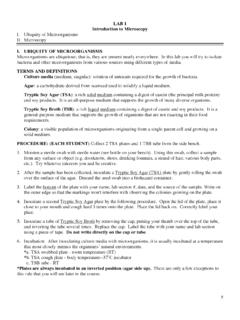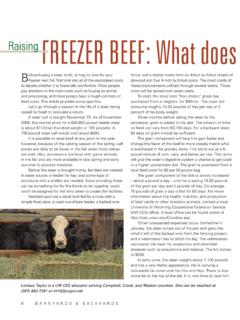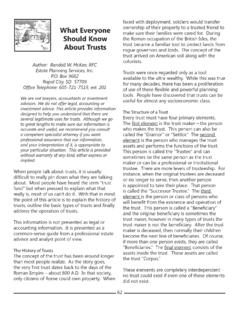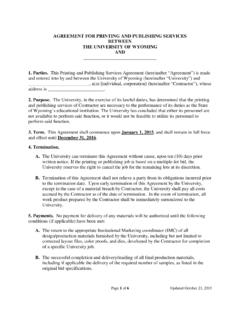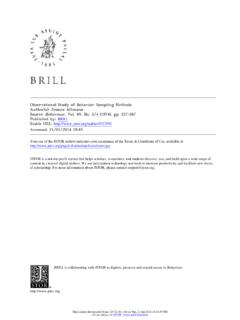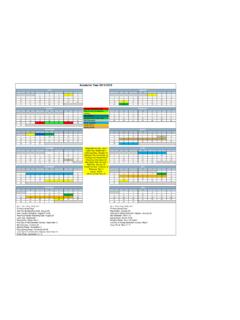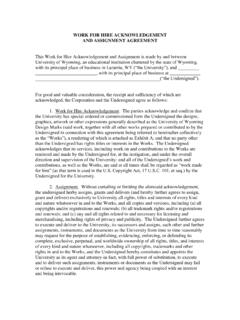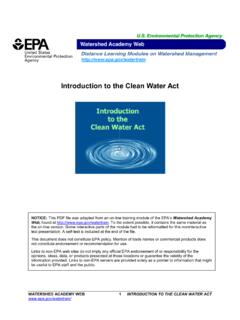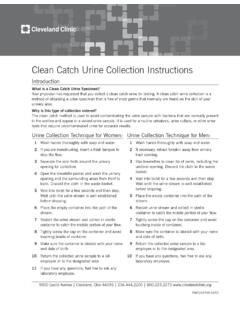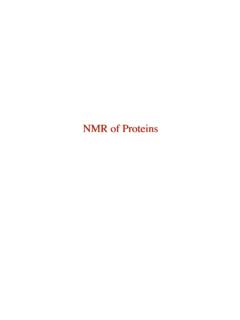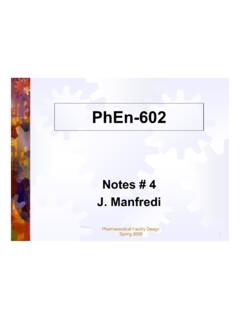Transcription of LAB 3 Bacterial Staining Techniques II I. Differential ...
1 21 LAB 3 Bacterial Staining Techniques II I. Differential Stains: Gram Stain and Acid-fast Stain II. Morphological Unknown I. Differential STAINS A. Gram Stain B. Acid-fast Stain A. Gram Stain The previous lab introduced simple Staining Techniques that enable microbiologists to observe the morphological characteristics of bacteria. Although simple stains are useful, they do not reveal details about the bacteria other than morphology and arrangement. The Gram stain is a Differential stain commonly used in the microbiology laboratory that differentiates bacteria on the basis of their cell wall structure.
2 Most bacteria can be divided into two groups based on the composition of their cell wall: 1) Gram-positive cell walls have a thick peptidoglycan layer beyond the plasma membrane. Characteristic polymers called teichoic and lipoteichoic acids stick out above the peptidoglycan and it is because of their negative charge that the cell wall is overall negative. These acids are also very important in the body s ability to recognize foreign bacteria. Gram-positive cell walls stain blue/purple with the Gram stain. 2) Gram-negative cell walls are more complex.
3 They have a thin peptidoglycan layer and an outer membrane beyond the plasma membrane. The space between the plasma membrane and the outer membrane is called the periplasmic space. The outer leaflet of the outer membrane is composed largely of a molecule called lipopolysaccharide (LPS). LPS is an endotoxin that is important in triggering the body s immune response and contributing to the overall negative charge of the cell. Spanning the outer membrane are porin proteins that enable the passage of small molecules. Lipoproteins join the outer membrane and the thin peptidoglycan layer.
4 Gram-negative cells will stain pink with the Gram stain. This is The Most Important Staining technique in Bacteriology. Cell wall structure of Gram+ and Gram- 22 GRAM STAIN Cell Color Procedure Reagent Gram Positive Gram Negative Fixed cells on slide COLORLESS COLORLESS Primary stain Crystal Violet PURPLE PURPLE Mordant Iodine PURPLE PURPLE Decolorizer Alcohol PURPLE COLORLESS Counterstain Safranin PURPLE RED An easy way to remember the steps of the Gram stain 23 PROCEDURE: (EACH STUDENT) 1. Using a sterile inoculating loop, add 1 drop of sterile water to the slide.
5 Prepare a mixed smear of Escherichia coli (G- rod) and Staphylococcus epidermidis (G+ coccus). 2. Air dry and Heat fix. 3. Cover the smear with Crystal Violet (primary stain) for 1 min. 4. Gently wash off the slide with water . 5. Add Gram s Iodine (mordant) for 1 min. 6. Wash with water . 7. Decolorize with 95% ethanol. This is the "tricky" step. Stop decolorizing with alcohol as soon as the purple color has stopped leaching off the slide (time will vary depending on thickness of smear). Immediately wash with water . Be sure to dispose of all ethanol waste in the appropriately labeled waste container.
6 8. Cover the smear with Safranin for 30 seconds. 9. Wash both the top & the bottom of the slide with water . 10. Blot the slide with bibulous paper. 11. Using the 10X objective lens, focus first on the line and then on the smear. Follow the focusing procedure in Lab #1. Use the focusing procedure in Lab #2 to view the smear using the 100X (oil immersion lens). Focus lineE. coliS. epidermidis Note: Escherichia coli is a tiny pink (Gram-) rod. Staphylococcus epidermidis is a purple (Gram+) sphere or coccus. Draw a picture of a typical microscopic field and identify both Escherichia coli and Staphylococcus epidermidis.
7 Record this in the results section for this lab. Colored pencils are available throughout the room on the chalkboard trays. 24 B. Acid-fast Stain Mycobacterium and many Nocardia species are called acid-fast because during an acid-fast Staining procedure they retain the primary dye carbol fuchsin despite decolorization with the powerful solvent acid-alcohol (95% ethanol with 3% HCl). Nearly all other genera of bacteria are nonacid-fast. The acid-fast genera have the waxy hydroxy-lipid called mycolic acid in their cell walls. It is assumed that mycolic acid prevents acid-alcohol from decolorizing protoplasm.
8 The acid-fast stain is a Differential stain. Ziehl Neelsen Acid-fast stain ACID-FAST STAIN Cell Color Procedure Reagent Acid-fast Bacteria Nonacid-fast Bacteria Primary dye Carbolfuchsin RED RED Decolorizer Acid-alcohol RED COLORLESS Counterstain Methylene blue RED BLUE PROCEDURE - (EACH STUDENT) 1. Add one loopful of sterile water to a microscope slide. 2. Make a heavy smear of Mycobacterium smegmatis. Mix thoroughly with your loop. Then transfer a small amount of Staphylococcus epidermidis to the same drop of water . You will now have a mixture of M.
9 Smegmatis and S. epidermidis. 3. Air dry and heat fix well. 4. Cover the smear with carbolfuchsin dye. Place a piece of paper towel on top of the dye. Be sure the paper towel is saturated with the dye. Carbolfuchsin is a potential carcinogen. Please wear gloves when working with this dye. 5. Place the slide on the rack over dry heat for 2 minutes. 6. Cool and rinse with water . 7. Decolorize by placing a drop of acid alcohol on the slide and allowing it to sit for 15 seconds. 8. Wash the top and bottom of slide with water and clean the slide bottom well.
10 9. Counterstain with Methylene Blue for 30 seconds to 1 minute. 10. Wash and blot the slide with bibulous paper. 11. Focus 10X - then use oil immersion. lineM(heavy)epidermidisS. Draw a typical microscopic field and record in Results Lab 3. Note: The acid-fast Mycobacterium retains carbolfuchsin and stains hot pink. The Staphylococcus epidermidis is decolorized and the counterstain colors them blue. See table for acid-fast stain. 25 II. Morphological Unknown: continue your investigation of your morphological unknown. 1. Collect your unknown from the side bench.


